A Comprehensive Guide for Tie Down Hooks
Tie down hooks play a very important role in maintaining the stability of cargo, distributing the weight of cargo, and maintaining the balance of the vehicle. Especially when you are transporting heavy cargo or irregularly shaped items, proper securement can avoid accidents caused by cargo shifting.
What are Tie Down Hooks?
Tie down hooks are the essential tools used to secure the cargo during transportation. They are mainly made of metal materials, such as carbon steel, stainless steel, etc. The tie down strap hooks always work with the anchor straps, chains, or ropes, providing a strong connection between the cargo and trucks, trailers, ships, or other modes of conveyance.
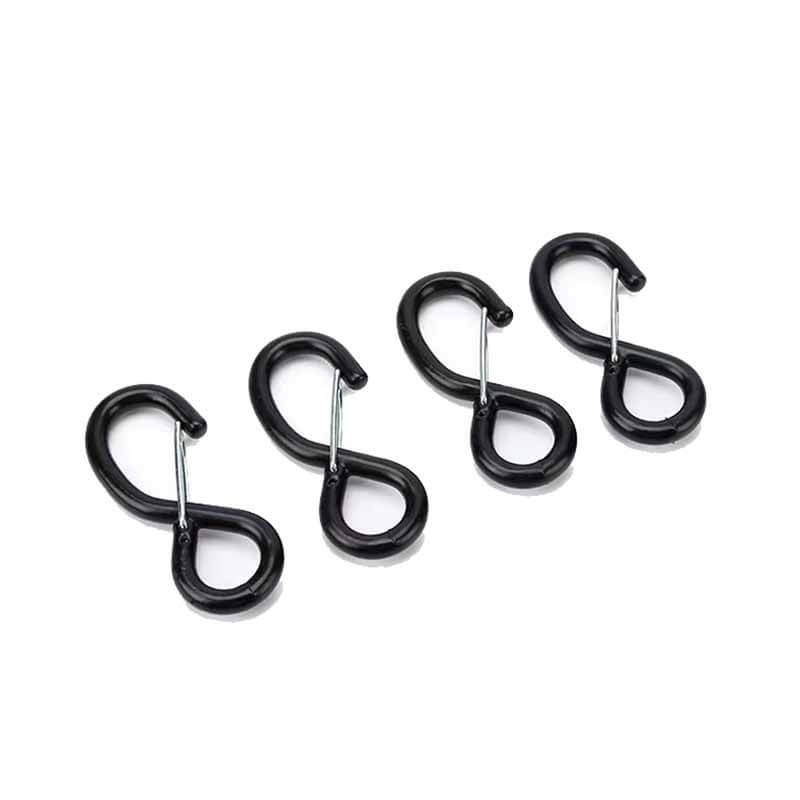
Metal S Hook
Metal S hook can be also named an S hook tie-down. This is one of the most commonly used types of tie down hooks, due to its efficient design and ease of use. As the name suggests, this hook shape looks like an “S“, made from durable materials such as steel or stainless steel, ensuring high tensile strength and resistance to corrosion. One end features a closed hook that needs to be attached to the strap, and the other end is open for easy attachment to anchor points.
Application of Metal S Hooks
S hook tie-downs are versatile, and you can see from many applications, including:
Light to Medium-Duty Hauling: S hooks are perfect for securing lightweight to medium-weight cargo. Such as household moves, DIY projects, and transporting everyday items like furniture, bicycles, and small machinery.
Camping and Outdoor Gear: S hooks are also a very convenient tool for outdoor trips. Such as they can used for tents, sleeping bags, camping chairs to roof racks, or inside a vehicle.
Recreational Activities: Metal S hooks can be used for securing surfboards, kayaks, or bicycles when heading to the beach or trails for leisure activities.
Garden and Landscaping: S hook tie-downs are valuable for securing gardening equipment, potted plants, or landscaping materials during transportation.
Safety Considerations When Using Metal S Hook
Although the metal S hook is easy to use, there are still some safety considerations you need to pay attention to.
Proper Attachment: Although the metal S hook is easy to use, you should also securely attach it to the anchor points and make sure the attachment points are sturdy and can handle the weight and tension of the cargo.
Avoid Overloading: Pay attention to the load capacity of the S hook you are using, overloading will cause the hook deformation or failure and then lead to potential risks.
Protection Against Abrasion: Use corner protectors to protect the tie downs from abrasion on rough surfaces and sharp edges. This will increase the entire service life of tie down straps.
Regular Inspection: Inspect the S hooks before every use. If you find any signs of wear, deformation, or damage, replace the worn-out or damaged hooks immediately.
Secure the Loose End: After attaching the S hook to the anchor point, please make sure you have secured the loose end of the tie down strap to avoid flapping or coming loose during transit.
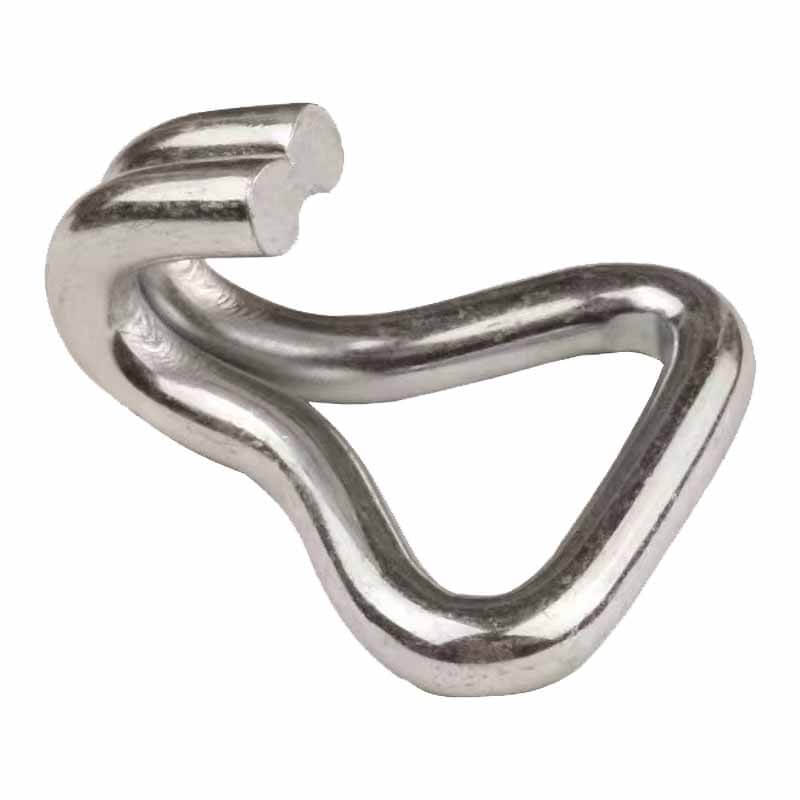
Strap Wire Hook
Strap wire hook is one of the tie down hooks that are commonly used for securing heavy-duty cargo. They are made from strong steel, creating a solid design that makes a solid connection between tie down straps and anchor points.
Application of Strap Wire Hook
Commercial Freight Transport: Wire hooks are extensively used in the transportation of heavy and bulky cargo, such as construction materials, machinery, and industrial equipment.
Flatbed Trucking: In flatbed trucking, loads are always heavy-duty and need robust securing, you always need the wire hook to connect the strap and flatbed anchor point.
Cargo Containers: The cargo within the shipping container is heavy duty and needs to take a long time to the destination. The wire hooks always take responsibility for securing the cargo in the container.
Flatbed Trailers and Semitrailers: Also, you can see that wire hooks are widely used in flatbed trailers and semitrailers for some loads that can not be transported by enclosed space.
Advantages and Limitations of Strap Wire Hooks
Since wire hook is a commonly used tie down hook, what are its advantages and limitations?
Advantages
High Strength and Durability: Wire hooks are made from strong materials, so they can provide exceptional strength and durability to handle heavy loads.
Secure Locking Mechanism: Some wire hooks also have a latch or safety clip on them to further ensure the tight securement between the tie down strap and hook, and avoid accidental detachment.
Versatility: Wire hooks can be seen in various tie down applications, such as tie-down straps, chains, and ropes.
Suitable for Heavy Loads: It is also a simple and easy-to-use hook, but wire hooks are suitable for securing heavy loads.
Limitations
Limited Flexibility: Compared to some other easy-to-use hooks, the wire hooks are less flexible than S hooks and snap hooks.
Potential for Abrasion: If not use proper corner or edge protectors, wire hooks may cause abrasion to tie-down straps when in direct contact with the cargo.
Weight: Wire hooks are always heavier than other simple tie down hooks, so if you use wire hooks, the overall weight of your cargo will be heavier.
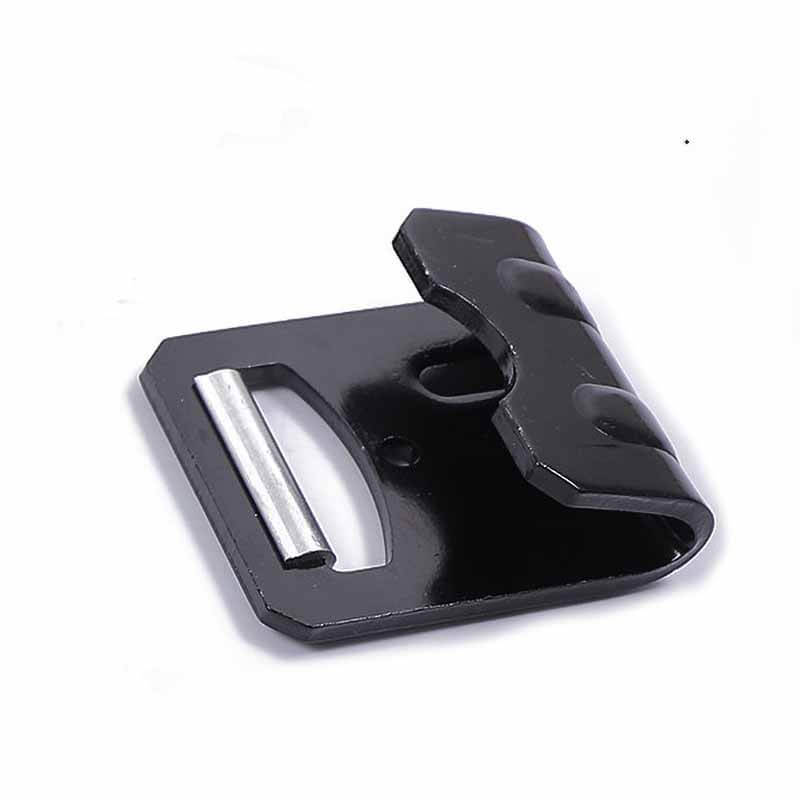
Flat Hook
Flat hook is always used with flat webbing together, this is what we call, a flat hook strap. The flat hook is in a wide and flat shape, there is a notch or slot that can hold the webbing in place. Flat hooks are made from steel or heavy-duty aluminum.
Applications of Flat Hook
Flatbed Trucking: Flat Hook always works with 3 inch webbing or 4 inch webbing to securely hold large or heavy items in flatbed trucking.
Oversized Loads: When transporting oversized or irregularly shaped cargo that cannot be contained within a standard container, flat hooks provide a strong connection to anchor points on the trailer or truck bed.
Vehicle Transportation: As you can see, for automotive transportation, flat hooks are always used to secure the vehicles to maximize stability during transportation.
Industrial Equipment: Industrial machinery and equipment are another application that needs a flat hook to hold them in place.
Flat Hooks vs. Other Tie Down Hooks
Flat Hooks vs. S Hooks: Flat hooks offer a more secure grip on webbing straps than S hooks, making them better suited for heavy-duty hauling and oversized loads.
Flat Hooks vs. Wire Hooks: Flat hooks are more suitable for secure heavy-duty cargo, while wire hooks are more suitable for medium-duty cargo.
Flat Hooks vs. Snap Hooks: Flat hooks are always attached to 3 or 4 inch webbing, but snap hooks are always attached to 1 or 2 inch webbing, due to their different loading capacity.
Flat Hooks vs. Chain Extensions: Chain extensions are used to provide additional length to chains, while flat hooks are used to secure webbing straps. Chain extensions are preferred in heavy industrial settings where chains are the primary choice for cargo securing.
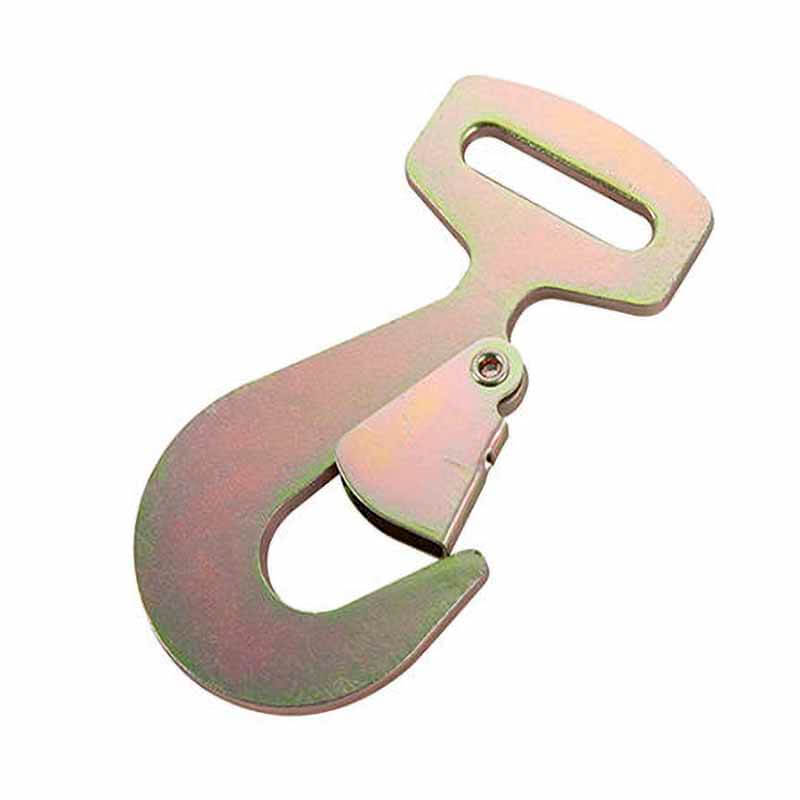
Snap Hook
Snap hooks are designed for quick and effortless attachment. These hooks feature a spring-loaded keeper mechanism that allows the hook to open and close smoothly, forming a completely unopened shape, effectively reducing the risk of end fittings detaching from the anchor points.
Applications of Snap Hook
Snap hook tie-downs are widely used for multiple purposes due to their quick and secure attachment features. Some common applications include:
Cargo Transportation: Snap hook is an ideal tie down hook to attach the 1 inch webbing and 2 inch webbing to create tie down straps.
Recreational Activities: These hooks are commonly used in outdoor activities, such as camping, hiking, and sports, to secure equipment, gear, and tents.
Roof Racks and Luggage Carriers: Snap hook tie-downs are suitable for securing luggage and cargo on roof racks or luggage carriers for road trips.
Canopy and Tarp Fastening: They are practical for securing canopies and tarps, offering a simple yet secure attachment to anchor points or ropes.
Safety Considerations of Snap Hooks
Spring-Loaded Keeper: The spring-loaded keeper in snap hooks ensures a self-closing mechanism, this could reduce the risk of the tie-down straps accidentally detaching from anchor points.
Versatility and Compatibility: Snap hooks are compatible with almost all anchor points, so they can be used in various tying-down situations.
Twisted Snap Hooks: Twisted snap hooks provide enhanced maneuverability and prevent straps from becoming tangled, making them suitable for specific tie-down points.
Weight Capacity: Snap hooks are always not used to secure heavy loads, so when you use them, check their working load limit carefully.
Regular Inspection: Regularly inspect snap hooks for any signs of wear, damage, or deformation. Replace the damaged one promptly if you find any.
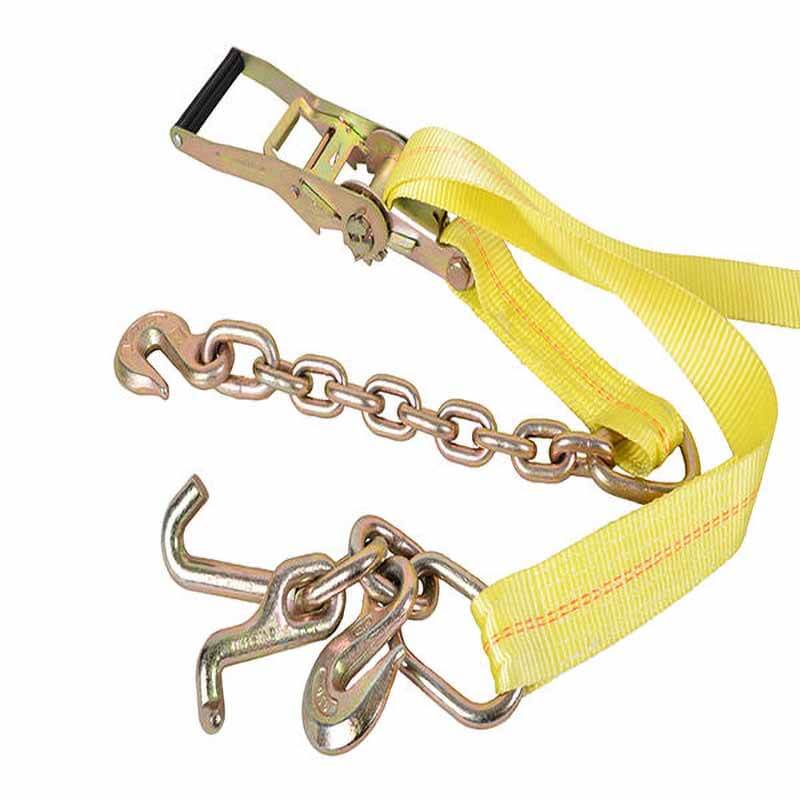
Chain Extension
Chain extensions are specifically designed to extend the length of chain or tie down straps, made from durable and heavy-duty steel, the hook on both ends can easily attach to the anchor points.
Application of Chain Extension
Oversized Loads: Chain Extensions are always used to transport oversized or irregularly shaped cargo that requires a longer reach to secure properly.
Securement Flexibility: If your cargo size changes, the chain extension allows you to adjust the length of the original chain, providing a custom-fit securing solution.
Construction Materials: Due to the chain extension is resistant to wear, and it is widely used in the construction industry to secure heavy equipment, lumber, and construction materials.
Industrial Applications: Transport machinery and heavy equipment always need chain extensions, because they are resistant to wear and add extra strength to the original tie downs.
Load Capacity and Strength Considerations of Chain Extension
Working Load Limit (WLL): Even the primary chain added with the chain extension, you should also check the working load limit of the entire chain, in order to avoid the chain can not securely hold the cargo.
Material and Construction: High-quality chain extensions are made from durable steel, so they can offer adequate strength and reliability during transportation.
Inspection and Maintenance: Regular inspection of the chain extension is necessary. If you find signs of wear, damage, or deformation, replace them immediately.
Proper Attachment: Ensure that both ends of the chain extension are securely attached to the anchor points. Proper attachment is essential for reliable cargo securement.
Compatibility: Ensure the two ends of the chain extension can fit the primary chain hook and anchor point.
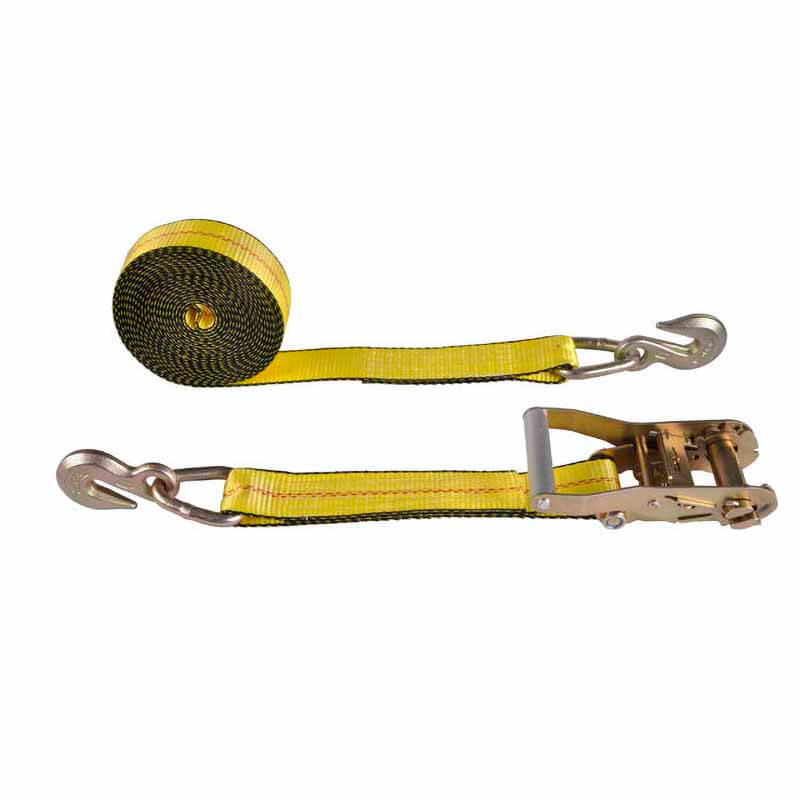
Clevis Grab Hook
Clevis grab hook is designed for heavy-duty hauling and industrial applications, normally used together with chains. This hook is normally made from robust steel which can withstand high levels of tension and demanding conditions.
Application of Clevis Grab Hook
Industrial Equipment Transport: When transporting heavy machinery and equipment always use the clevis grab hook to secure, it due to its heavy-duty features.
Construction Materials: You can also see the flatbed truckers use the clevis grab hook to secure the steel beams, concrete barriers, and construction machinery on their vehicle.
Flatbed Trucking: Clevis grab hooks with chains, as strong tie downs, always provide a secure connection for flatbed trucking, ensuring that the cargo remains stable and safe during transit.
What Are the Surface Treatments of Tie Down Hooks?
Having surface treatments on the tie down hooks will improve its performance, so let’s take a look at what surface treatments are available.
Galvanizing: Coating the surface of the hook with a layer of zinc to enhance its corrosion resistance.
Spray Coating: Use spray technology to apply a coating to the surface of the hook to increase its surface hardness and corrosion resistance.
Electroplating: The hook is immersed in the plating solution, and a metal coating, such as nickel, chromium, or copper, is formed on its surface through an electrochemical reaction to improve its appearance and corrosion resistance.
Phosphating Treatment: Dip the surface of the hook into a solution containing phosphorus compounds to form a phosphide layer on the surface to improve its corrosion resistance and hardness.
Hot-Dip Galvanizing: The hook is heated to a high temperature and then immersed in zinc liquid to form a zinc coating on the surface to improve its corrosion resistance.
Electrophoresis: Through electrophoresis coating, the paint particles are attracted to the surface of the hook under the action of the electric field, forming a uniform and dense coating during the coating process. This coating has good corrosion resistance and adhesion and can provide excellent appearance.
How to Choose the Right Tie Down Hooks for Your Transportation?
There are wide range of tie down hooks in the market, but their roles and application areas are different. Let us take a look at what you need to consider before choosing the right tie down hooks.
Weight Capacity: First, you need to know the weight of the cargo clearly, then the tie down hooks with its working load limit you found must exceed the weight of the load.
Hook Type: Each tie down hook has its specific feature and application, choose the one that fits your needs or ask the seller to recommend it to you.
Material and Durability: Not all the tie down hooks are made from the same material, you need to choose the proper material and its durability according to your needs.
Attachment Method: The two ends of tie down hooks need to attach to the tie down straps, chains, ropes, and anchor points. So, choose the proper one after checking the attached points.
Cargo Shape and Size: There are different types, sizes, and shapes of items you need to transport, choose the proper tie downs with their end fitting for different cargo securement.
Application: Some hooks are better suited for recreational activities, while others excel in industrial or heavy-duty hauling.
Safety Tips for Using Tie-Down Hooks
Proper inspection and maintenance of tie down hooks are very important, they can extend the service life of hooks, and ensure safety during transportation.
Regular Inspections: Before each use, inspect tie-down hooks for signs of wear, deformation, or damage. Check for rust, cracks, or bent components, and replace any worn-out or damaged hooks immediately.
Clean and Lubricate: Keep tie-down hooks clean and free from debris or contaminants. Lubricate the moving parts regularly to maintain their smoothness.
Storage: Store the tie down hooks in a dry place, don’t expose them to environmental elements when they are not in use.
Tie-down hooks play a critical role in ensuring the safe and secure transportation of cargo. Contact Webslingness to customize your tie down needs!
You may also interested in:
Your ultimate ratchet strap resource for cargo control
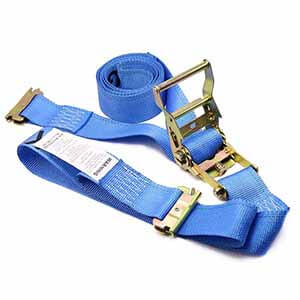
Dave Lee
Dave Lee has amassed over two decades of experience in the cargo control industry, serving as a product manager. Prior to joining Webslingness, he spent three years at a transportation company.


